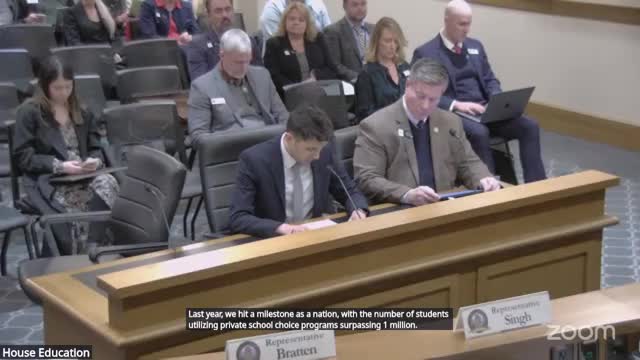Wyoming residents express alarm over education quality as House Bill 199 proposes school choice expansion
January 22, 2025 | Education Committee, House of Representative, Committees, Legislative, Wyoming
This article was created by AI summarizing key points discussed. AI makes mistakes, so for full details and context, please refer to the video of the full meeting. Please report any errors so we can fix them. Report an error »

In a recent meeting of the House Education Committee, a stark picture of Wyoming's educational landscape emerged, driven by fresh polling data that revealed deep-seated concerns among residents. As committee members gathered, the atmosphere was charged with urgency, reflecting the pressing need for reform in the state's K-12 education system.
The newly released poll indicated that a staggering 77% of Wyoming residents believe that education across the country is on the wrong track. This sentiment extended to local schools, where only 35% of respondents felt positively about their own districts' direction. The findings underscore a growing demand for alternatives to the traditional education model, as families express a desire for change.
At the heart of the discussion was House Bill 199, which aims to expand the Education Savings Account (ESA) program and introduce the Wyoming Freedom Scholarship. The proposal has garnered notable support, with 52% of residents backing ESAs, while only 17% opposed them. Furthermore, 57% of those surveyed believe that ESAs should be accessible to all families, regardless of income.
Advocates for the bill, including representatives from EdChoice, highlighted the potential benefits of school choice. They referenced extensive research showing that 84% of studies on school choice programs report positive outcomes, ranging from improved test scores to increased parent satisfaction. The financial implications were also significant, with proponents noting that the average spending per pupil in school choice programs is approximately $6,000, compared to $17,000 in district schools.
The meeting also touched on fiscal concerns, particularly in light of Arizona's experience with ESAs. Contrary to fears of budget crises, Arizona reported a $20 million surplus last year, with projections indicating a $500 million surplus for the current year. This data was presented to counteract misconceptions about the financial viability of school choice initiatives.
As the committee deliberates on House Bill 199, the discussions reflect a broader national conversation about educational reform and the quest for solutions that better serve families and students. With a clear call for action resonating from the community, the future of education in Wyoming hangs in the balance, poised for potential transformation.
The newly released poll indicated that a staggering 77% of Wyoming residents believe that education across the country is on the wrong track. This sentiment extended to local schools, where only 35% of respondents felt positively about their own districts' direction. The findings underscore a growing demand for alternatives to the traditional education model, as families express a desire for change.
At the heart of the discussion was House Bill 199, which aims to expand the Education Savings Account (ESA) program and introduce the Wyoming Freedom Scholarship. The proposal has garnered notable support, with 52% of residents backing ESAs, while only 17% opposed them. Furthermore, 57% of those surveyed believe that ESAs should be accessible to all families, regardless of income.
Advocates for the bill, including representatives from EdChoice, highlighted the potential benefits of school choice. They referenced extensive research showing that 84% of studies on school choice programs report positive outcomes, ranging from improved test scores to increased parent satisfaction. The financial implications were also significant, with proponents noting that the average spending per pupil in school choice programs is approximately $6,000, compared to $17,000 in district schools.
The meeting also touched on fiscal concerns, particularly in light of Arizona's experience with ESAs. Contrary to fears of budget crises, Arizona reported a $20 million surplus last year, with projections indicating a $500 million surplus for the current year. This data was presented to counteract misconceptions about the financial viability of school choice initiatives.
As the committee deliberates on House Bill 199, the discussions reflect a broader national conversation about educational reform and the quest for solutions that better serve families and students. With a clear call for action resonating from the community, the future of education in Wyoming hangs in the balance, poised for potential transformation.
View full meeting
This article is based on a recent meeting—watch the full video and explore the complete transcript for deeper insights into the discussion.
View full meeting